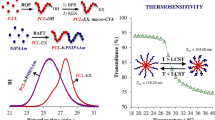Abstract
Tri-block poly(lactide)–poly(ethylene glycol)–poly(lactide) (PLA–PEG–PLA) copolymers were synthesized and self-assembled into micelles in aqueous solution by double emulsion and nanoprecipitation methods. These micelles were loaded by atorvastatin and lisinopril as hydrophobic and hydrophilic model drugs, respectively. The resulting nanostructures were characterized by various techniques. Atomic force microscopy images disclosed that the micelles have spherical structure with the average size of 100 nm. The micelles exhibited high encapsulation efficiency of about 48 ± 0.13% and 84 ± 0.13 for atorvastatin and lisinopril, respectively. Fourier transform infrared spectroscopy and differential scanning calorimetry confirmed that strong interaction between atorvastatin and copolymer was the major driving force behind drug loading which subsequently lead to more sustained release behavior of corresponding micelles. Whereas, in case of lisinopril there was no evidence for strong interaction between drug and copolymer. The surface adsorption was the main parameter for drug loading which in turn caused the drug to be quick released. Overall, the results indicated that PLA–PEG–PLA micelles can be considered as a promising carrier for both hydrophilic and hydrophobic drugs with different release characteristics.





Similar content being viewed by others
References
Asadi H, Rostamizadeh K, Salari D, Hamidi M (2011) Preparation and characterization of tri-block poly(lactide)–poly(ethylene glycol)–poly(lactide) nanogels for controlled release of naltrexone. Int J Pharm 416:356–364
Danafar H, Davaran S, Rostamizadeh K, Valizadeh H, Hamidi M (2014a) Biodegradable m-PEG/PCL core-shell micelles: preparation and characterization as a sustained release formulation for curcumin. Adv Pharm Bull 4:501–510
Danafar H, Rostamizadeh K, Davaran S, Hamidi M (2014b) PLA-PEG-PLA copolymer-based polymersomes as nanocarriers for delivery of hydrophilic and hydrophobic drugs: preparation and evaluation with atorvastatin and lisinopril. Drug Dev Ind Pharm 40:1411–1420
Danafar H, Rostamizadeh K, Davaran S, Hamidi M (2015) Drug-conjugated PLA–PEG–PLA copolymers: a novel approach for controlled delivery of hydrophilic drugs by micelle formation. Pharm Dev Technol. doi:10.3109/10837450.2015.1125920
Danafar H, Manjili HK, Najafi M (2016) Study of copolymer composition on drug loading efficiency of enalapril in polymersomes and cytotoxicity of drug loaded nanoparticles. Drug Res 66: 495–504
Davis YY, Bates FT (1999) Giant wormlike rubber micelles. Science 283:960–963
He G, Lwin Ma L, Pan J, Venkateraman V (2007) ABA and BAB type triblock copolymers of PEG and PLA: a comparative study of drug release properties and stealth particle characteristics. Int J Pharm 334:48–55
Hu K, Li J, Shen Y, Lu W, Gao X, Jiang X (2009) Lactoferrin-conjugated PEG–PLA nanoparticles with improved brain delivery: in vitro and in vivo evaluations. J Control Release 134:55–61
Huang Y, Chung T, Tzeng T (1997) Drug release from PLA/PEG microparticulates. Int J Pharm 156:9–15
Jones MC, Leroux JC (2002) Polymeric micelles a new generation of colloidal drug carrier. Eur J Pharm Biopharm 48:101–111
Kheiri Manjili H, Ghasemi P, Malvandi M, Mousavi M, Attari E, Danafar H (2016) Pharmacokinetics and in vivo delivery of curcumin by copolymeric mPEG-PCL micelles. Eur J Pharm Biopharm. doi:10.1016/j.ejpb.2016.10.003
Lassalle V, Ferreira ML (2007) PLA nano and microparticles for drug delivery: an overview of the methods of preparation. Macromol Biosci 7:767–783
Lee ALZ, Wang Y, Yang Y (2009) The co-delivery of paclitaxel and Herceptin using cationic micellar nanoparticles. Biomaterials 30:919–927
Li S, Vert M (1996) Hydrolytic degradation of the coral/poly(DL-lactic acid) bioresorbable material. J Biomater Sci Polym Ed 9:817–827
Li X, Deng X, Yuan M, Xiong C, Huang Z, Zhang Y, Jia W (2000) In vitro degradation and release profiles of poly-dl-lactide–poly(ethylene glycol) microspheres with entrapped proteins. J Appl Polym Sci 1:140–148
Li L, Chenxi L, Xuechen L, Zhi Y, Yingli A, Binglin H (2001) Biodegradable polylactide/poly(ethylene glycol)/polylactide triblock copolymer micelles as anticancer drug carriers. J Appl Polym Sci 80:1976–1982
Luo W, Li S, Bei J, Wang Sh (2002) Dependence of morphology on composition of polylactide/poly(ethylene glycol)/polylactide multiblock copolymers. Polym Adv Technol 13:233–238
Manjili HK, Sharafi A, Danafar H, Hosseini M, Ramazani A, Ghasemi MH (2016) Poly (caprolactone)–poly (ethylene glycol)–poly (caprolactone)(PCL–PEG–PCL) nanoparticles: a valuable and efficient system for in vitro and in vivo delivery of curcumin. RSC Adv 6:14403–14415
Pratten MK, Lloyd JB, Horpel G, Ringsdorf H (1985) Micelle-forming block copolymers: pinocytosis by macrophages and interaction with model membranes. Makromol Chem 186:725
Ruan G, Feng S-S (2003) Preparation and characterization of poly(lactic acid)–poly(ethylene glycol)–poly(lactic acid) (PLA–PEG–PLA) microspheres for controlled release of paclitaxel. Biomaterials 24:5037–5044
Venkatraman SS, Jie P, Minb F, Chiang B, Leong G (2005) Micelle-like nanoparticles of PLA–PEG–PLA triblock copolymer as chemotherapeutic carrier. Int J Pharm 298:219–232
Wang H, Zhao Y, Wua Y, Hub Y, Nan K (2011) Enhanced anti-tumor efficacy by co-delivery of doxorubicin and paclitaxel with amphiphilic methoxy PEG-PLGA copolymer nanoparticles. Biomaterials 3:8281–8290
Acknowledgements
This work has been supported financially by Faculty of Pharmacy, Zanjan University of Medical Sciences, Zanjan, Iran. All authors (H. Danafar, K. Rostamizadeh, and H. Hamidi) declare that they have no conflict of interest. This article does not contain any studies with human or animal subjects performed by any of the authors.
Author information
Authors and Affiliations
Corresponding author
Rights and permissions
About this article
Cite this article
Danafar, H., Rostamizadeh, K. & Hamidi, M. Polylactide/poly(ethylene glycol)/polylactide triblock copolymer micelles as carrier for delivery of hydrophilic and hydrophobic drugs: a comparison study. J. Pharm. Investig. 48, 381–391 (2018). https://doi.org/10.1007/s40005-017-0334-8
Received:
Accepted:
Published:
Issue Date:
DOI: https://doi.org/10.1007/s40005-017-0334-8




